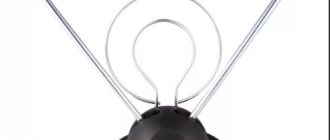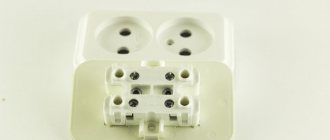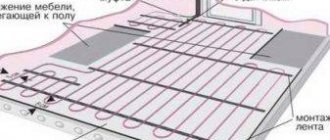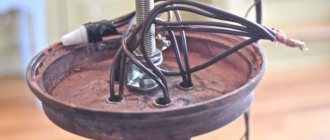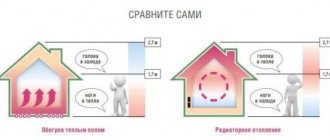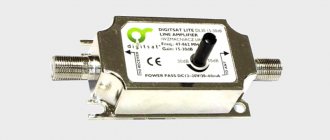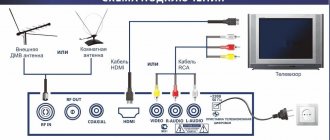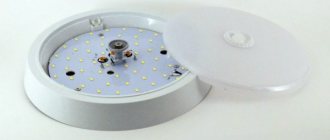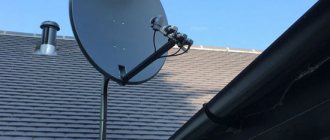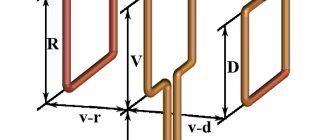Connecting an antenna to a TV is a simple operation that anyone can handle.
A television antenna can be indoor or outdoor. An indoor TV antenna converts electric current into electromagnetic radiation. Indoor antennas are usually installed on the walls of rooms. Also, indoor television antennas can be installed outside the room (on the balcony, on the roof, terrace, etc.). Such antennas are called external.
Outdoor antennas are usually installed using a mast, which can be fixed or mobile. The mast can be installed either on the ground or on the wall of the house.
When choosing an outdoor antenna, you should consider the distance between the place where it will be installed and the TV. It is best if the outdoor antenna is aimed at a tall building, which will provide a wider spectrum of the received signal.
What is needed to connect
To connect the antenna you must have:
- Antenna cable with a characteristic impedance of 75 Ohms and a length of 10 meters.
- Splitter (tee) for 3 outputs.
- Fuse 3A.
Depending on the size and shape of the roof, you will need to cut off part of the antenna cable and run it through the roof to the antenna installation location. Then, depending on the shape and presence of windows in the upper part of the house, make holes in the roof and place the antenna cable in a groove on the ceiling or wall.
All operations with the antenna and cable must be performed with the TV's power supply turned off and disconnected from the network. If difficulties arise when installing the antenna on the roof, you can use ladders, railings and stepladders.
Antenna cable selection
The antenna cable used to transmit television signals at high speed is relatively large in size and weight.
For its manufacture, wires from the following alloys are used:
- copper-nickel alloy MNMts 43-1 (M – copper, N – nickel, 4 3 – valence);
- copper-chromium bronze BrKh – 4 (X – chromium, C – zinc);
- copper-nickel alloys with the addition of silicon (MC, MVS, MSN).
When choosing an antenna cable, you need to consider the following factors: frequency of the TV, cable length, presence or absence of an amplifier. It should be taken into account that high-frequency cables should not have high breaking strength. In addition, they must be flexible. It is recommended to use copper wires as connecting conductors.
For large distances between the television center and the receiving location, the cable must have sufficient length. If the TV is installed in a room, it is preferable to use a short cable length. Do not use stranded wires, especially when using a television amplifier.
In this case, a large level of noise arises, since the signal in such a circuit is not divided into components. The antenna television cable must have mechanical strength. Otherwise, the cable may become severely bent.
Antenna plug selection
An antenna plug is an element of an antenna connecting cord designed to connect an antenna to a connector on the corresponding device. It is a tube with a threaded connection. The choice of antenna plug depends on what kind of device and antenna will be connected to it.
If it will be connected to a television receiver, then a digital TV plug is needed. And if you need to connect the antenna to a satellite tuner, then you already need a T2 plug. In order to choose the right plug, you need to pay attention to the fact that the kit should contain not only a plug, but also fasteners for it - a clamp for attaching to the antenna. Antennas are available for various types of TVs.
If the TV is an old model with a picture tube, you need to use the TV antenna plug, since it has a pin. If the TV is LCD or plasma, you need a plug with a pin. In modern technology, either a plug with two terminals or a so-called “tulip” is used to connect to a TV.
Assembling the cable and connecting the antenna to the TV
The antenna is connected to the TV with a two-core cable marked TV antenna. The wire must be connected to the TV and antenna connectors on the rear panel. Connectors are usually white. If the connector is made in the form of two pins inserted into each other, it should be connected directly to the antenna socket of the TV.
Then connect the antenna cable to the TV using plugs or connectors, if available. This must be done before you assemble the cable. When connecting the cable, be careful not to make mistakes that could ruin the image quality. Once the connection is complete, turn on the TV.
Connecting a TV to a common house antenna
Here's how to connect your TV to a public antenna:
- The antenna must have a connector for connecting the cable: SMA socket. This connector must use a 75 ohm cable of appropriate length.
- If the TV is already connected to a public television antenna, you need to switch to AV mode in order to connect the TV to the AV input of the TV.
- If the antenna cable is connected to the TV, then use an AV adapter with a slot for a CAM module (for example, Tesler TCA-16). Insert one end of the cable into the “AV in” connector and the other into the CAM slot connector on the TV. Connect the CAM module (if available) to the CAM slot and remove the cable plug from the common connector.
- If the TV is not connected to a shared television antenna or to an antenna cable, then insert the cable connector into the TV and the other end into the “TV IN” connector.
- After connecting the antenna to the TV, make sure that the antenna is turned on and an image appears on the TV screen.
- When you turn on your TV for the first time, check your audio settings. To do this, you need to enter the menu through the on-screen keyboard using the MENU button, then select the “Sound” option in the menu that appears.
- To return to the previous menu level, press the ENTER button.
- To move to the next menu level, press the “up” or “down” button.
- To switch audio-video modes, use the Up or Down navigation buttons.
Connecting to an individual antenna
An individual antenna is an antenna that is installed directly on the balcony or in the house. If you have a TV that operates on the UHF band and you do not have access to the central television channel (Rostelecom, MTS), then you can try connecting it to an individual antenna installed on the roof of the house. In this case, decimeter channels will be available.
How to connect a TV to a UHF antenna.
The antenna consists of the following parts:
- UHF signal amplifier.
- Indoor antenna.
- Room splitter (tee).
- Cable.
- Wall bracket.
So, how to connect a TV to an individual UHF antenna? Before you begin, make sure your connection matches the amplifier's operation. To do this, you need to connect your home antenna to the amplifier using a cable. The terminals labeled "A1", "A2" and "B1" are needed to connect to the wires from the antenna, and the "C1" terminal will be used to connect to the amplifier.
Connection to wire “A1” is mandatory, since it is a signal input, and to the wire on “A2” you can connect a digital set-top box or tuner (receiver), which may not be included in the television antenna. Install the indoor antenna at a height of 1.5 meters from the ground and secure it to the wall using a bracket. Don't forget to connect the ground.
This can be done using a bolt and nut or a bolt and terminal. If you have a satellite dish amplifier, use its input to connect your TV.
How to connect an antenna to a tricolor and a TV set-top box
You can connect the antenna to the tricolor using the simplest, most convenient and practical device - a repeater. The antenna for cable television in the country must be powerful, otherwise its operation will be ineffective. For example, if it does not respond in terms of decibels, then it is best to choose the type of antenna that has a power of 40-50 decibels.
Such an antenna will perfectly receive signals from three or more channels. And in order to connect it to the TV, you need to purchase a special repeater unit that has the appropriate power.
In the case of an amplifier, it will need to be connected to an antenna.
Block repeaters come in two types:
- For one device.
- As a set.
The first option is the simplest, but also the most expensive. It is mainly used for older TVs. The second option is universal and can be used with any old TV or monitor. Such repeaters are connected using a cable.
The cable must be special so as not to damage it during operation. You can connect the antenna to the TV set-top box using the so-called F-connector. If it is missing, then you need to use an adapter. It is sold in specialized stores. Also, to connect the antenna to the TV, you can use a special adapter from antenna to HDMI. If your TV does not have a set-top box, the settings are made differently.
TOP 6 best antenna amplifiers for TVs
Some amplifiers are popular due to the simplicity of their design, low cost and easy installation. If necessary, you can replace and repair them yourself.
When purchasing an external amplifier, you need to take care of its tightness. External devices are replaced every 2 years, even if they are protected. For this reason, it is better to try to find a place for the amplifier under the roof.
Antenna amplifier F-02
All-wave main amplification device with power supply via cable. It amplifies the TV signal in the meter and decimeter range with an operating range (1-12 k) and UHF (21-60 k). Gain: up to 25 dB, noise figure: up to 2 dB, supply voltage: 12 V.
Estimated cost: 350 rubles.
Delta UATIP-03 MV+UHF
An amplifying broadband device for individual use in the meter (from 1 to 12 channels) and decimeter (21 to 69 channels) range. Power supply 12 V.
Estimated cost: 672 rubles.
SWA-999 for “mesh”
Amplifier for a Polish antenna (“grid”) with an operating frequency range from 48 to 862 MHz and a 12 V power supply. Gain - 28-34 dB.
Estimated cost: 113 rubles.
Amplifier SWA-999 from Eurosky
REMO INDOOR USB (BAS-8102 5V)
A multi-purpose antenna amplifier that converts a passive antenna into an active one and allows you to get rid of the power supply for the antenna amplifier. Gain: up to 16 dB. Power supply - 5 V.
Estimated cost: 245 rubles.
REMO Booster-DiGi (BAS-8207)
Antenna amplifier with an average gain of 21-69 channels. Power supply - 12 V. Noise figure - no more than 2.8 dB.
Estimated cost: 425 rubles.
Planar 21-69 FT series
Antenna amplifier for cable with a frequency range from 470 to 468 MHz and a gain of up to 22 dB. Power supply - 12 V. Noise figure - 4 dB.
Estimated cost: 350 rubles.
Setup after connection
The setting may vary on different TV models. To carry this out, there is a special regulator on the back panel of the TV, as well as buttons: “Menu”, “Auto search”, “Manual tuning”, and the “Auto tuning” function. If you connect the antenna to the TV via a cable and press the control, the main menu will display information about whether there is a signal or about the absence of a signal.
If the TV does not turn on when you connect the antenna, the reason may be a malfunction of the power supply that is included with the TV.
Setting up channels for a Samsung TV
The setting is done on the remote control.
If you have a Samsung TV with a remote control function, just find the “Settings” section in the menu and follow these steps:
- “Channel settings” – to search for channels that you want to tune;
- “Automatic tuning” – searching for channels through the corresponding menu section;
- “Manual tuning” – enter and search for channels manually.
Setting up channels for LG TV
Settings are performed using the remote control or using the buttons on the TV body. To do this, go to the “Menu” section and select “Settings”.
For a LG TV with Smart TV technology, some menu functions may include a channel search item . It is located in the “Options” section, “Search for channels” subsection.
Setting up channels for a Sony TV
This is done using the TV remote control or using the buttons on its body. Settings are made in the same menu item as for TVs of other brands. To start setting up, go to the “Settings” menu item, then open the “Teletext” section.
To perform a search, go to the “Autosearch” subsection. Then press the “OK” button on the TV remote control and go to the search section by selecting “ON”.
In this case, you can proceed to the next setup step automatically. To switch between pages, press the “Page down” key. If necessary, you can additionally search by frequency and polarization. For other TV models (Dexp, Philips, Toshiba, Panasonic, Smart Samsung, Sony, Supra, BBK, Horizon, Vityaz, Tcl, Dexp, Haier and others), the settings are made in a similar way.
Connecting multiple TVs to one antenna
Connecting several TVs to one antenna is done using one of the following technologies:
- using a cable TV signal splitter;
- using signal splitters.
When connecting several TVs to one TV antenna cable and if there is a splitter or splitter, the signal will be divided between the TVs, and the image quality will be determined by the characteristics of each TV.
On each of them you can adjust the image in accordance with the settings on the TV. The signal splitter transmits the signal in its pure form to each of the TVs.
Thus, each TV will have its own image, as well as its own audio and video (for example, if you connect a second TV to the audio system). In addition, you can install several antenna sockets on the antenna, then you can connect several TVs to it. In this case, each TV will have its own image and audio.
Splitters and signal splitters are connected to the antenna with one cable, but the splitter transmits the signal to several TVs, and the splitters also distribute it between different antenna sockets.
Temporary connection of an antenna cable without a plug
If you urgently need to connect the antenna, but there is no plug at hand, you can do without it for a while.
A quick connection is done like this:
- the top insulation approximately 5 cm long is removed from the cable;
- the shielding braid is bent back;
- the central core is stripped of insulation and bent into a loop slightly wider than the diameter of the hole in the center of the antenna connector;
- a dielectric tube is put on the central contact (for example, from the removed insulation from the central core);
- the loop is inserted into the central contact, the braid is tucked into the connector using a screwdriver. The main thing here is to prevent contact between the central core and the shielding braid;
- if aluminum braiding is used, then it is simply inserted into the connector, and the free space is filled with small wires;
- to prevent the cable from falling out, it is tightened with a pair of sharpened matches;
- If contact has been achieved, the TV will begin to receive a signal from the antenna.
What affects signal quality
During the seasonal increase in the number of household antennas for receiving satellite channels, owners of new TVs are increasingly faced with the problem of poor television signal reception - especially in densely built areas, or on low floors.
The quality of the TV signal is influenced by several factors:
- Antenna type. Outdoor antennas are typically only capable of receiving signals from one satellite, while indoor antennas are capable of receiving all satellites used in a country. But even if your TV has a built-in antenna, its capabilities are not limitless. For example, it will not be able to receive a signal from several satellites at once, nor will it be able to amplify the signal of some broadcasters, unlike the Clear TV antenna.
- Antenna location. The higher the antenna is located, the stronger the signal. It is also worth noting that the signal level is affected by the direction and angle of the antenna itself - for example, if the angle of inclination is too large, the signal quality may decrease significantly.
- Food quality. High-quality power not only ensures stable operation of the antenna, but also improves its reception. If you want to avoid constant freezes and shutdowns, it is recommended to connect the TV through a stabilized voltage source.
Where to go if problems arise?
The ARS-Master repair shop does not do miracles and will not be able to entertain you instead of watching TV. But the work of our specialists can be called real magic. And all because we know everything about receiving and transmitting devices:
- Differences between indoor and outdoor antennas.
- Operating principles of satellite, digital and cable television.
- Features of connecting antennas of different types and modifications.
- Pros and cons of TV brands, including built-in capabilities of the models.
- We can imagine connection diagrams even with our eyes closed.
The company's specialists successfully apply their knowledge and experience in practice. During our work, we have successfully connected several tens of thousands of antennas, laid kilometers of coaxial cable, and securely secured millions of plugs, adapters and connectors.
You can contact ARS-Master in the following cases:
- I don’t want to have to deal with connecting the TV antenna myself.
- There is no desire to understand the theory of connection, but I want to see an interesting program today.
- You don’t understand anything about the connection diagram, the cable, amplifiers, plugs, tuners and other elements.
- An attempt to complete the work on our own was unsuccessful and the desired result was not achieved.
- Consultation is required regarding the purchase of additional equipment for connection.
With a connection from ARS-Master, the television antenna always transmits brighter, faster, and better!
When and why do you need a signal amplifier? How to connect an antenna amplifier
A signal amplifier for a TV is a device that, unlike an antenna, does not receive a signal, but amplifies it. A signal amplifier is needed in cases where the TV antenna receives a signal with interference, or the signal is very weak.
If you have an amplifier, the signal will be amplified, making the image on the screen clearer. In addition, a TV with an amplifier will receive the signal without interference or distortion.
The cost of such a device depends on its type, complexity and scope of function (signal amplification, gain level adjustment, etc.). In some models, the cost starts from 1000 rubles.
Temporary connection of an antenna cable without a plug
If you urgently need to connect the antenna, but there is no plug at hand, you can do without it for a while.
A quick connection is done like this:
- the top insulation approximately 5 cm long is removed from the cable;
- the shielding braid is bent back;
- the central core is stripped of insulation and bent into a loop slightly wider than the diameter of the hole in the center of the antenna connector;
- a dielectric tube is put on the central contact (for example, from the removed insulation from the central core);
- the loop is inserted into the central contact, the braid is tucked into the connector using a screwdriver. The main thing here is to prevent contact between the central core and the shielding braid;
- if aluminum braiding is used, then it is simply inserted into the connector, and the free space is filled with small wires;
- to prevent the cable from falling out, it is tightened with a pair of sharpened matches;
- If contact has been achieved, the TV will begin to receive a signal from the antenna.
